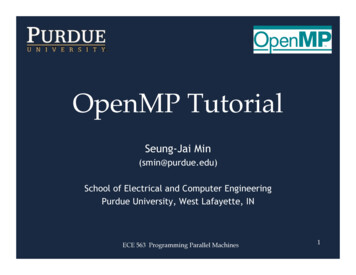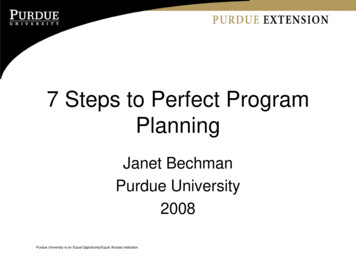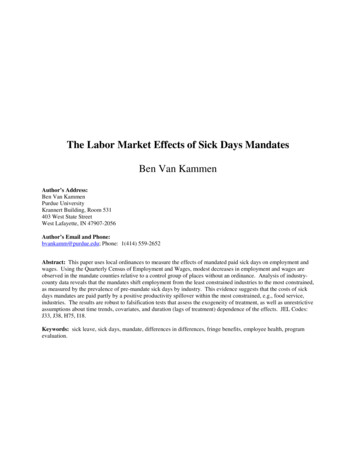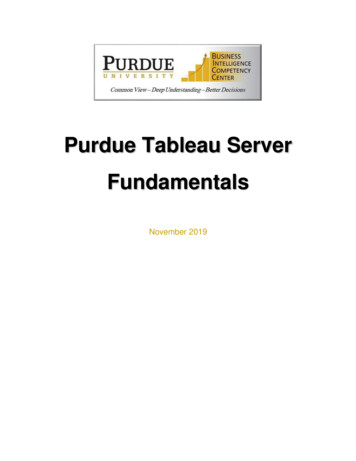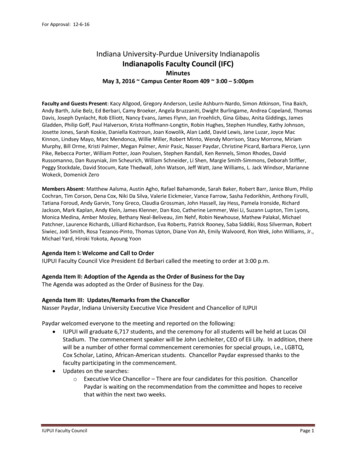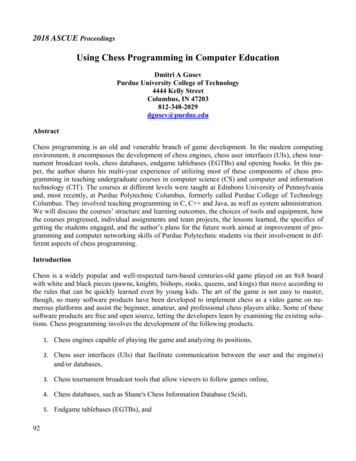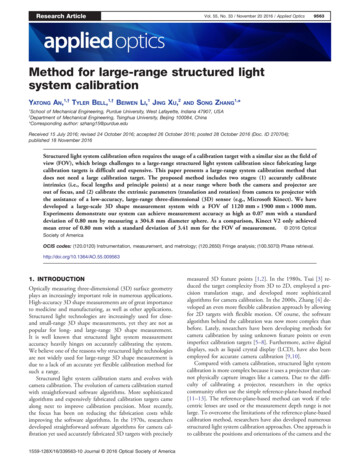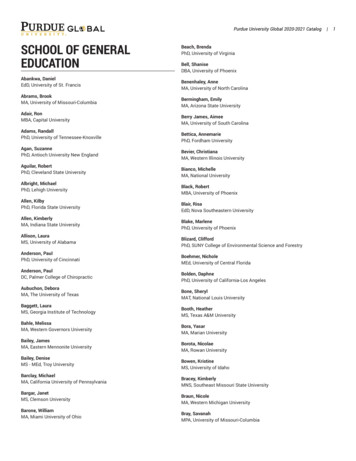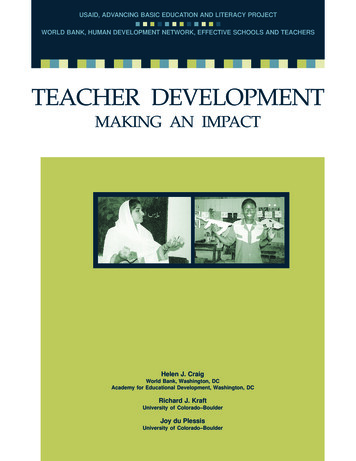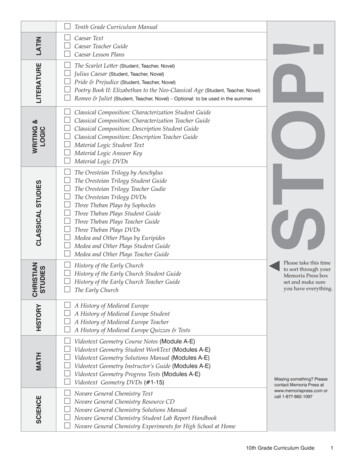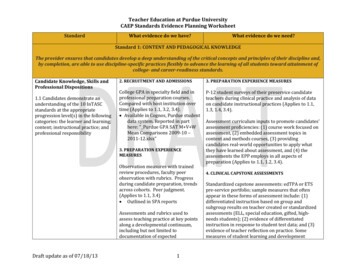
Transcription
Teacher Education at Purdue UniversityCAEP Standards Evidence Planning WorksheetStandardWhat evidence do we have?What evidence do we need?Standard 1: CONTENT AND PEDAGOGICAL KNOWLEDGEThe provider ensures that candidates develop a deep understanding of the critical concepts and principles of their discipline and,by completion, are able to use discipline‐specific practices flexibly to advance the learning of all students toward attainment ofcollege‐ and career‐readiness standards.Candidate Knowledge, Skills andProfessional Dispositions1.1 Candidates demonstrate anunderstanding of the 10 InTASCstandards at the appropriateprogression level(s) in the followingcategories: the learner and learning;content; instructional practice; andprofessional responsibility2. RECRUITMENT AND ADMISSIONS3. PREPARATION EXPERIENCE MEASURESCollege GPA in specialty field and inprofessional preparation courses.Compared with host institution overtime (Applies to 1.1, 3.2, 3.4). Available in Cognos, Purdue studentdata system. Reported in parthere: “ Purdue GPA SAT M V WMean Comparisons 2009-10 –2011-12.xlsx”P-12 student surveys of their preservice candidateteachers during clinical practice and analysis of dataon candidate instructional practices (Applies to 1.1,1.3, 1.4, 3.4).3. PREPARATION EXPERIENCEMEASURESObservation measures with trainedreview procedures, faculty peerobservation with rubrics. Progressduring candidate preparation, trendsacross cohorts. Peer judgment.(Applies to 1.1, 3.4) Outlined in SPA reportsAssessments and rubrics used toassess teaching practice at key pointsalong a developmental continuum,including but not limited todocumentation of expectedDraft update as of 07/18/131Assessment curriculum inputs to promote candidates’assessment proficiencies: (1) course work focused onassessment, (2) embedded assessment topics incontent and methods courses, (3) providingcandidates real-world opportunities to apply whatthey have learned about assessment, and (4) theassessments the EPP employs in all aspects ofpreparation (Applies to 1.1, 1.2, 3.4).4. CLINICAL CAPSTONE ASSESSMENTSStandardized capstone assessments: edTPA or ETSpre-service portfolio; sample measures that oftenappear in these forms of assessment include: (1)differentiated instruction based on group andsubgroup results on teacher created or standardizedassessments (ELL, special education, gifted, highneeds students); (2) evidence of differentiatedinstruction in response to student test data; and (3)evidence of teacher reflection on practice. Somemeasures of student learning and development
Teacher Education at Purdue UniversityCAEP Standards Evidence Planning WorksheetStandardWhat evidence do we have?instructional practices and candidateperformance (Applies to 1,1, 1.3, 1.4,2.3 and 3.4). Addressed in TaskStream,performance assessments in theGates.Student performance on valid, reliableassessments aligned with instructionduring clinical practice experiences.Trends over time. Peer judgment(Applies to 1.1, 1.3, 1.4, Standards 3,4) Addressed in TaskStream, StudentTeaching PerformanceAssessmentDescriptive evidence of candidates’graduated responsibility for allaspects of classroom teaching andincreasing ability to impact allstudents’ learning. Peer judgment(Applies to 1.1, 2.3, 3.4). Outlined in SPA reportsAnalysis of video recorded lessonswith review and evaluation based onrubrics and disinterested raters.(Applies to 1.1, 3.4). Addressed in TaskStream, StudentTeaching PerformanceAssessmentDraft update as of 07/18/132What evidence do we need?included. Average cohort scores compared withnational norms or national cut scores (applies to 1.1,1.3, 1.4, 2.3, 3.5)5. LICENSURE AND EXIT ASSESSMENTSGRE field tests when applicable, cohort average scorecompared with national norms in: Biochemistry, celland molecular biology; biology; chemistry; computerscience; Literature in English; Mathematics; Physicsand Psychology (applies to 1.1, 3.5).Connecticut/Pearson Foundations of Readinglicensure test, cohort average compared with statenorms (applies to 1.1, 3.5).
Teacher Education at Purdue UniversityCAEP Standards Evidence Planning WorksheetStandardWhat evidence do we have?4. CLINICAL CAPSTONE ASSESSMENTSClinical capstone assessments; also,evidence from a culminatingexperience with a significant level ofcandidate responsibility for all aspectsof classroom teaching and increasedability to impact all students’ learningand development. Subscale scorescompared with rubric values (appliesto 1.1, 1.3, 2.3, 3.5) Addressed in TaskStream, StudentTeaching PerformanceAssessmentAbility of candidates to design and usea variety of formative candidates toreflect on personal biases, accessappropriate resources to deepen theirunderstanding, use this informationand related experiences to buildstronger relationships with P-12learners, and adapt their practices tomeet the needs of each learner. Peerjudgment (applies to 1.1, 2.3, 3.5). Outlined in SPA reportsState required performance measures,orother appropriate performancemeasures (applies to 1.1, 1.3, 1.4, 2.3,3.4, 3.5). Outlined in SPA reportsDraft update as of 07/18/133What evidence do we need?
Teacher Education at Purdue UniversityCAEP Standards Evidence Planning WorksheetStandardWhat evidence do we have?5. LICENSURE AND EXIT ASSESSMENTSState licensure exams: there should bea recommended specific and commoncut-score across states, and a passrate of 80% within twoadministrations. CAEP should workwith states to develop and employnew or revised licensure tests thataccount for college and careerreadiness standards, and establish acommon passing score for all states.(Note: Recent reports from CCSSO,Our Responsibility, Our Promise:Transforming Educator Preparationand Entry into the Profession, andfrom AFT, Raising the Bar: AligningandElevating Teacher Preparation and theEducation Profession, addresspreparation and entry requirements,indicating growing support for vastlyimproved licensure assessments.)(Applies to 1.1, 3.4) OPPL Guidelines for Licensure,Key Assessment 1ETS Praxis test, ElementaryEducation:Multiple Subjects, cohort averagecomparedDraft update as of 07/18/134What evidence do we need?
Teacher Education at Purdue UniversityCAEP Standards Evidence Planning WorksheetStandardWhat evidence do we have?What evidence do we need?with state and national norms (appliesto 1.1, 3.5). OPPL Guidelines for Licensure,Key Assessment 1ETS Major field tests: average cohortscore compared with national norms(Applies to 1.1, 1.3, 3.5). OPPL Guidelines for Licensure,Key Assessment 1 also from USDept. of Education, “Recent Trendsin Mean Scores and Characteristicsof Test-Takers on Praxis IILicensure TestsProvider Responsibilities3. PREPARATION EXPERIENCE MEASURESAssessment curriculum inputs to promote candidates’assessment proficiencies: (1) course work focused onassessment, (2) embedded assessment topics incontent and methods courses, (3) providingcandidates real-world opportunities to apply whatthey have learned about assessment, and (4) theassessments the EPP employs in all aspects ofpreparation (Applies to 1.1, 1.2, 3.4).1.2 Providers ensure that completersuse research and evidence to developan understanding of the teachingprofession and use both to measuretheir P‐12 students’ progress andtheir own professional practice.1.3 Providers ensure that completersapply content and pedagogicalknowledge as reflected in outcomeassessments in response tostandards of Specialized ProfessionalAssociations (SPA), the NationalBoard for Professional TeachingStandards (NBPTS), states, or otherDraft update as of 07/18/133. PREPARATION EXPERIENCEMEASURESAssessments and rubrics used toassess teaching practice at key pointsalong a developmental continuum,including but not limited to53. PREPARATION EXPERIENCE MEASURESP-12 student surveys of their preservice candidateteachers during clinical practice and analysis of dataon candidate instructional practices (Applies to 1.1,1.3, 1.4, 3.4).
Teacher Education at Purdue UniversityCAEP Standards Evidence Planning WorksheetStandardaccrediting bodies (e.g., NationalAssociation of Schools of Music –NASM).What evidence do we have?documentation of expectedinstructional practices and candidateperformance (Applies to 1,1, 1.3, 1.4,2.3 and 3.4). Addressed in TaskStream,performance assessments in theGates.Ability of candidates to design and usea variety of formative assessmentswith P-12 students. Peer judgment.(Applies to 1.3, 3.6) Outlined in SPA reportsStudent performance on valid, reliableassessments aligned with instructionduring clinical practice experiences.Trends over time. Peer judgment(Applies to 1.1, 1.3, 1.4, Standards 3,4) Outlined in SPA reports andTaskStream4. CLINICAL CAPSTONE ASSESSMENTSClinical capstone assessments; also,evidence from a culminatingexperience with a significant level ofcandidate responsibility for all aspectsof classroom teaching and increasedability to impact all students’ learningand development. Subscale scoresDraft update as of 07/18/136What evidence do we need?4. CLINICAL CAPSTONE ASSESSMENTSStandardized capstone assessments: edTPA or ETSpre-service portfolio; sample measures that oftenappear in these forms of assessment include: (1)differentiated instruction based on group andsubgroup results on teacher created or standardizedassessments (ELL, special education, gifted, highneeds students); (2) evidence of differentiatedinstruction in response to student test data; and (3)evidence of teacher reflection on practice. Somemeasures of student learning and developmentincluded. Average cohort scores compared withnational norms or national cut scores (applies to 1.1,1.3, 1.4, 2.3, 3.5)
Teacher Education at Purdue UniversityCAEP Standards Evidence Planning WorksheetStandardWhat evidence do we have?compared with rubric values (appliesto 1.1, 1.3, 2.3, 3.5) Addressed in TaskStream, StudentTeaching PerformanceAssessmentState required performance measures,orother appropriate performancemeasures (applies to 1.1, 1.3, 1.4, 2.3,3.4, 3.5) Outlined in SPA reports5. LICENSURE AND EXIT ASSESSMENTSETS Major field tests: average cohortscore compared with national norms(Applies to 1.1, 1.3, 3.5). OPPL Guidelines for Licensure,Key Assessment 1 also from USDept. of Education, “Recent Trendsin Mean Scores and Characteristicsof Test-Takers on Praxis IILicensure TestsAssessments and rubrics used toassess teaching practice at key pointsalong a developmental continuum,including but not limited todocumentation of expectedinstructional practices and candidateperformance (also applies to 1.3, 1.4,2.3 and 3.4).Draft update as of 07/18/137What evidence do we need?
Teacher Education at Purdue UniversityCAEP Standards Evidence Planning WorksheetStandardWhat evidence do we have? 1.4 Providers ensure that completersdemonstrate skills and commitmentthat afford all P‐12 students access torigorous college‐ and career‐readystandards (e.g., Next GenerationScience Standards, National CareerReadiness Certificate, Common CoreState Standards).Outlined in TaskStream3. PREPARATION EXPERIENCEMEASURESAssessments and rubrics used toassess teaching practice at key pointsalong a developmental continuum,including but not limited todocumentation of expectedinstructional practices and candidateperformance (Applies to 1.3, 1.4, 2.3and 3.4). Outlined in TaskStreamStudent performance on valid, reliableassessments aligned with instructionduring clinical practice experiences.Trends over time. Peer judgment(Applies to 1.1, 1.3, 1.4, Standards 3,4) Outlined in TaskStream1.5 Providers ensure that completersmodel and apply technologystandards as they design, implementand assess learning experiences toengage students and improvelearning; and enrich professionalpractice.Draft update as of 07/18/13What evidence do we need?83. PREPARATION EXPERIENCE MEASURESP-12 student surveys of their preservice candidateteachers during clinical practice and analysis of dataon candidate instructional practices (Applies to 1.1,1.3, 1.4, 3.4).
Teacher Education at Purdue UniversityCAEP Standards Evidence Planning WorksheetStandardWhat evidence do we have?What evidence do we need?Standard 2: CLINICAL PARTNERSHIPS AND PRACTICEThe provider ensures that effective partnerships and high‐quality clinical practice are central to preparation so that candidatesdevelop the knowledge, skills, and professional dispositions necessary to demonstrate positive impact on all P‐12 students’learning and development.Partnerships for ClinicalPreparation3. PREPARATION EXPERIENCEMEASURES2.1 Partners co‐construct mutuallybeneficial P‐12 school andcommunity arrangements, includingtechnology‐based collaborations, forclinical preparation and shareresponsibility for continuousimprovement of candidatepreparation. Partnerships for clinicalpreparation can follow a range offorms, participants, and functions.They establish mutually agreeableexpectations for candidate entry,preparation, and exit; ensure thattheory and practice are linked;maintain coherence across clinicaland academic components ofpreparation; and shareaccountability for candidateoutcomes.Shared understandings amongstpartners that guide educatorpreparation—common work, rolesand responsibilities, authority, andaccountability (dk, tbd).Clinical Educators3. PREPARATION EXPERIENCEMEASURES2.2 Partners co‐select, prepare,evaluate, support, and retain high‐Draft update as of 07/18/133. PREPARATION EXPERIENCE MEASURESMemoranda of understanding or data-sharingagreements with diverse P-12 and/or communitypartners. Peer judgment. (Are there any needs forrevision of the document or the nature of theagreement?)Evidence of tracking and sharing data such as hiringpatterns of the school district/school or job placementrates contextualized by partners’ needs. Peerjudgment. (should be available by DOE).Evidence of actions that indicate combined resourceallocation and joint decision-making such (1) programand course adjustments to meet partners’ humancapital and instructional needs, (2) statedcharacteristics and roles for on-site delivery ofprogrammatic courses and (3) recruitment ofcandidates to meet district teacher needs (e.g. inpipeline programs). Peer judgment.Plans, activities, and results related to9
Teacher Education at Purdue UniversityCAEP Standards Evidence Planning WorksheetStandardWhat evidence do we have?quality clinical educators, bothprovider‐ and school‐based, whodemonstrate a positive impact oncandidates’ development and P‐12student learning and development. Incollaboration with their partners,providers use multiple indicators andappropriate technology‐basedapplications to establish, maintain,and refine criteria for selection,professional development,performance evaluation, continuousimprovement, and retention ofclinical educators in all clinicalplacement settings.selection of diverse clinical educatorsand their support and retention (suchas training and support protocols,including implementation data withand for clinical educators in EPPprograms. Trends over time, peerjudgment. Guidelines and Agreements in OFEClinical Experiences3. PREPARATION EXPERIENCEMEASURES2.3 The provider works withpartners to design clinicalexperiences of sufficient depth,breadth, diversity, coherence, andduration to ensure that candidatesdemonstrate their developingeffectiveness and positive impact onall students’ learning anddevelopment. Clinical experiences,including technology‐enhancedlearning opportunities, arestructured to have multipleperformance‐based assessments atkey points within the program todemonstrate candidates’development of the knowledge, skills,Draft update as of 07/18/13Evidence of continuous opportunitiesfor formative feedback and coachingfrom high quality and diverse clinicaleducators. Peer judgment. Guidelines and Agreements in OFEEvidence that candidates integratetechnology into their planning andteaching and use it to differentiateinstruction. Peer judgment, or anassessment including technology asone among many dimensions, andtrends over time. Addressed in SPA reports10What evidence do we need?3. PREPARATION EXPERIENCE MEASURESPerformance data on candidate development of “highleverage” instructional practices/strategies—fromearly field work to culminating experience—in diverseclinical settings (urban, rural, high poverty, highachieving as well as non-traditional settings, such asafter school programs and community recreationprograms); including but not limited to evidence ofhow proficiencies are demonstrated with/in adiversity of partners, settings, and in partnership withschool-based faculty, families and communities; Peerjudgment.Evidence of candidates’ graduated responsibilitieswithin the classroom and impact on student learning.(Applies to 2.3, 3.4)
Teacher Education at Purdue UniversityCAEP Standards Evidence Planning WorksheetStandardand professional dispositions, asdelineated in Standard 1, that areassociated with a positive impact onthe learning and development of allP‐12 students.What evidence do we have?Evidence of candidates’ reflection oninstructional practices, observations,and their own practice with increasingbreadth, depth, and intention with aneye toward improving teaching andstudent learning (e.g., video analysis,reflection logs). Evaluation based onrubrics, peer judgment. Addressed in SPA reports andTaskStream Student TeachingPerformance AssessmentAssessments and rubrics used toassess teaching practice at key pointsalong a developmental continuum,including but not limited todocumentation of expectedinstructional practices and candidateperformance (also applies to 1.3, 1.4,2.3 and 3.4). Addressed in SPA reports andTaskStream Student TeachingPerformance AssessmentDescriptive evidence of candidates’graduated responsibility for allaspects of classroom teaching andincreasing ability to impact allstudents’ learning. Peer judgment(Applies to 1.1, 2.3, 3.4). Addressed in SPA reports andTaskStream Student TeachingPerformance AssessmentDraft update as of 07/18/1311What evidence do we need?Case study of the effectiveness of diverse fieldexperiences on candidates’ instructional practices.Peer judgment (Applies to 2.3, 5.3)Reliable and valid measures or innovative models ofhigh-quality practices, partnerships, clinical educators,or clinical experiences. Peer judgment (applies to 5.3,2.3).4. CLINICAL CAPSTONE ASSESSMENTSStandardized capstone assessments: edTPA or ETSpre-service portfolio; sample measures that oftenappear in these forms of assessment include: (1)differentiated instruction based on group andsubgroup results on teacher created or standardizedassessments (ELL, special education, gifted, highneeds students); (2) evidence of differentiatedinstruction in response to student test data; and (3)evidence of teacher reflection on practice. Somemeasures of student learning and developmentincluded. Average cohort scores compared withnational norms or national cut scores (applies to 1.1,1.3, 1.4, 2.3, 3.5).
Teacher Education at Purdue UniversityCAEP Standards Evidence Planning WorksheetStandardWhat evidence do we have?Videos of teaching: scores comparedwith rubric values and monitoredacross cohorts (applies to 2.3, 3.5) Addressed in SPA reports andTaskStream Student TeachingPerformance Assessment4. CLINICAL CAPSTONE ASSESSMENTSClinical capstone assessments; also,evidence from a culminatingexperience with a significant level ofcandidate responsibility for allaspects of classroom teaching andincreased ability to impact allstudents’ learning and development.Subscale scores compared with rubricvalues (applies to 1.1, 1.3, 2.3, 3.5). Addressed in SPA reports andTaskStream Student TeachingPerformance AssessmentProvider criteria for completion onopportunities for candidates to reflecton personal biases, access appropriateresources to deepen theirunderstanding, use this informationand related experiences to buildstronger relationships with P-12learners, and adapt their practices tomeet the needs of each learner. Peerjudgment (applies to 1.1, 2.3, 3.5).Draft update as of 07/18/1312What evidence do we need?
Teacher Education at Purdue UniversityCAEP Standards Evidence Planning WorksheetStandardWhat evidence do we have?What evidence do we need? Addressed in SPA reportsState required performance measures,or other appropriate performancemeasures (applies to 1.1, 1.3, 1.4, 2.3,3.4, 3.5). Addressed in SPA reportsStandard 3: CANDIDATE QUALITY, RECRUITMENT, AND SELECTIVITYThe provider demonstrates that the quality of candidates is a continuing and purposeful part of its responsibility fromrecruitment, at admission, through the progression of courses and clinical experiences, and to decisions that completers areprepared to teach effectively and are recommended for certification. The provider demonstrates that development of candidatequality is the goal of educator preparation in all phases of the program. This process is ultimately determined by a program’smeeting of Standard 4.Plan for Recruitment of DiverseCandidates who Meet EmploymentNeeds2. RECRUITMENT AND ADMISSIONSStrategic recruitment plans, based onEPP mission and employmentopportunities (including STEM and3.1 The provider presents plans andELL) for completers and needs togoals to recruit and supportserve increasingly diversecompletion of high‐qualitypopulations. Includes plans forcandidates from a broad range ofbackgrounds and diverse populations outreach, numerical goals and basedata, monitoring of progress, analysesto accomplish their mission. Theand judgment of adequacy of progressadmitted pool of candidates reflectstoward goals, and making indicatedthe diversity of America’s P‐12students. The provider demonstrates changes. Also (1) evidence ofresources moving toward identifiedefforts to know and addresstargets and away from low need areas;community, state, national, regional,(2) evidence of marketing andor local needs for hard‐to‐staffrecruitment at high schools andschools and shortage fields,colleges that are racially and culturallycurrently, STEM, English‐languageDraft update as of 07/18/1313
Teacher Education at Purdue UniversityCAEP Standards Evidence Planning WorksheetStandardWhat evidence do we have?What evidence do we need?learning, and students withdisabilities.diverse; and (3) evidence ofcollaboration with other providers,states, school districts as an indicatorof outreach and awareness ofemployment needs. Peer judgment. Student Services RecruitmentGuidelinesAdmission Standards IndicateThat Candidates Have HighAcademic Achievement AndAbility2. RECRUITMENT AND ADMISSIONS2. RECRUITMENT AND ADMISSIONSHigh school GPA for initial preparationat the undergraduate level.Comparison with host institutioncohort over time Available in Cognos, and as part ofthe teacher education retentionmodel).IB or AP exam scores: admitted cohort averagecompared with national norms.College GPA in specialty field and inprofessional preparation courses.Compared with host institution overtime (Applies to 1.1, 3.2, 3.4). Available in Cognos, Purdue studentdata system. Reported in parthere: “ Purdue GPA SAT M V WMean Comparisons 2009-10 –2011-12.xlsx”High school course taking (e.g. Advanced placement,higher level math and languages). Compare withnational norms. (Applies to 3.2, 3.5)3.2 The provider sets admissionsrequirements, including CAEPminimum criteria or the state’sminimum criteria, whichever arehigher, and gathers data to monitorapplicants and the selected pool ofcandidates. The provider ensuresthat the average grade point averageof its accepted cohort of candidatesmeets or exceeds the CAEP minimumof 3.0, and the group average 16 CAEP Commission Recommendationsto the CAEP Board of Directorsperformance on nationally normedability/achievement assessmentssuch as ACT, SAT, or GRE: is in thetop 50 percent from 2016‐2017; isin the top 40 percent of thedistribution from 2018‐2019; and isin the top 33 percent of theDraft update as of 07/18/13ACT or SAT scores; admitted cohortaverage compared with nationalnorms for initial preparation at theundergraduate level. Available in Cognos, and as part ofthe teacher education retention14GRE: admitted cohort average compared with nationalnorms for graduate level program (Applies to 3.2, 3.4).Academic awards. Compare over time.A reliable, valid model that uses admissions criteriaother than those in standard 3.2. The admitted cohortgroup mean on these criteria must meet or exceed thestandard that has been shown empirically topositively correlate with measures of P-12 studentlearning and development. (Applies to 3.2, 5.3)
Teacher Education at Purdue UniversityCAEP Standards Evidence Planning WorksheetStandarddistribution by 2020.30Additional Selectivity FactorsWhat evidence do we have?What evidence do we need?model).3. PREPARATION EXPERIENCEMEASURES3. PREPARATION EXPERIENCE MEASURESCase study of how developing non-academic factorsrelate to subsequent teacher performance; also,illustrate candidate commitment and dispositionssuch as (1) teaching, volunteerism, coaching, civicorganizations, commitment to urban issues; (2)content related, goal oriented, data-drivencontributions/value-add to current employer ororganization; (3)mindsets/dispositions/characteristics such ascoachability, empathy, teacher presence of “with-itness,” cultural competency, collaboration, beliefs, thatall children can learn; or (4) professionalism,perseverance, ethical practice, strategic thinking,abilities to build trusting, supportive relationshipswith students and families during preparation. Peerjudgment. Applies to 3.3, 3.4, 5.3; (dk, tbd).3.3 Educator preparation providersestablish and monitor attributes anddispositions beyond academic abilitythat candidates must demonstrate atadmissions and during the program.The provider selects criteria,describes the measures used andevidence of the reliability andvalidity of those measures, andreports data that show how theacademic and non‐academic factorspredict candidate performance in theprogram and effective teaching.Demonstration of assessments of non-academicquality of candidates and how these relate to teacherperformance (student self-assessments, letters ofrecommendation, interviews, essays, leadership,surveys, Gallup measures, strength finder 2/0, MyersBriggs, personality tests). Peer judgment (Applies to3.3, 3.4).Selectivity During Preparation2. RECRUITMENT AND ADMISSIONS2. RECRUITMENT AND ADMISSIONS3.4 The provider creates criteria forCollege GPA in specialty field and inGRE: admitted cohort average compared with nationalDraft update as of 07/18/1315
Teacher Education at Purdue UniversityCAEP Standards Evidence Planning WorksheetStandardWhat evidence do we have?What evidence do we need?program progression and monitorscandidates’ advancement fromadmissions through completion. Allcandidates demonstrate the ability toteach to college‐ and career‐readystandards. Providers presentmultiple forms of evidence toindicate candidates’ developingcontent knowledge, pedagogicalcontent knowledge, pedagogicalskills, and the integration of31technology in all of these domains.professional preparation courses.Compared with host institution overtime (Applies to 1.1, 3.2, 3.4). Available in Cognos, Purdue studentdata system. Reported in parthere: “ Purdue GPA SAT M V WMean Comparisons 2009-10 –2011-12.xlsx”norms for graduate level program (Applies to 3.2, 3.4).3. PREPARATION EXPERIENCEMEASURESAssessments and rubrics used toassess teaching practice at key pointsalong a developmental continuum,including but not limited todocumentation of expectedinstructional practices and candidateperformance (Applies to 1.1, 1.3, 1.4,2.3, 3.4).Analysis of video recorded lessonswith review and evaluation based onrubrics and disinterested raters.(Applies to 1.1, 3.4). Addressed in TaskStream, StudentTeaching PerformanceAssessmentObservation measures with trainedreview procedures, faculty peerobservation with rubrics. ProgressDraft update as of 07/18/13163. PREPARATION EXPERIENCE MEASURESEvidence of candidates’ graduated responsibilitieswithin the classroom and impact on student learning.(Applies to 2.3, 3.4)Demonstration of assessments of non-academicquality of candidates and how these relate to teacherperformance (student self-assessments, letters ofrecommendation, interviews, essays, leadership,surveys, Gallup measures, strength finder 2/0, MyersBriggs, personality tests). Peer judgment (Applies to3.3, 3.4).P-12 student surveys of their preservice candidateteachers during clinical practice and analysis of dataon candidate instructional practices (Applies to 1.1,1.3, 1.4, 3.4).Assessment curriculum inputs to promote candidates’assessment proficiencies: (1) course work focused onassessment, (2) embedded assessment topics incontent and methods courses, (3) providingcandidates real-world opportunities to apply whatthey have learned about assessment, and (4) theassessments the EPP employs in all aspects ofpreparation (Applies to 1.1, 1.2, 3.4).
Teacher Education at Purdue UniversityCAEP Standards Evidence Planning WorksheetStandardWhat evidence do we have?during candidate preparation, trendsacross cohorts. Peer judgment.(Applies to 1.1, 3.4) Outlined in SPA reportsDescriptive evidence of candidates’graduated responsibility for allaspects of classroom teaching andincreasing ability to impact allstudents’ learning. Peer judgment(also applies to 1.1, 2.3). Addressed in SPA reports andTaskStream Student TeachingPerformance Assessment4. CLINICAL CAPSTONE ASSESSMENTSState required performance measures,or other appropriate performancemeasures (applies to 1.1, 1.3, 1.4, 2.3,3.4, 3.5). Addressed in SPA reports5. LICENSURE AND EXIT ASSESSMENTSState licensure exams: there should bea recommended specific and commoncut-score across states, and a passrate of 80% within twoadministrations. CAEP should workwith states to develop and employnew or revised licensure tests thataccount for college and careerreadiness standards, and establish a
ETS Major field tests: average cohort score compared with national norms (Applies to 1.1, 1.3, 3.5). OPPL Guidelines for Licensure, Key Assessment 1 also from US ept. of ducation, "Recent Trends in Mean Scores and Characteristics of Test-Takers on Praxis II Licensure Tests Provider Responsibilities 1.2 Providers ensure that completers
